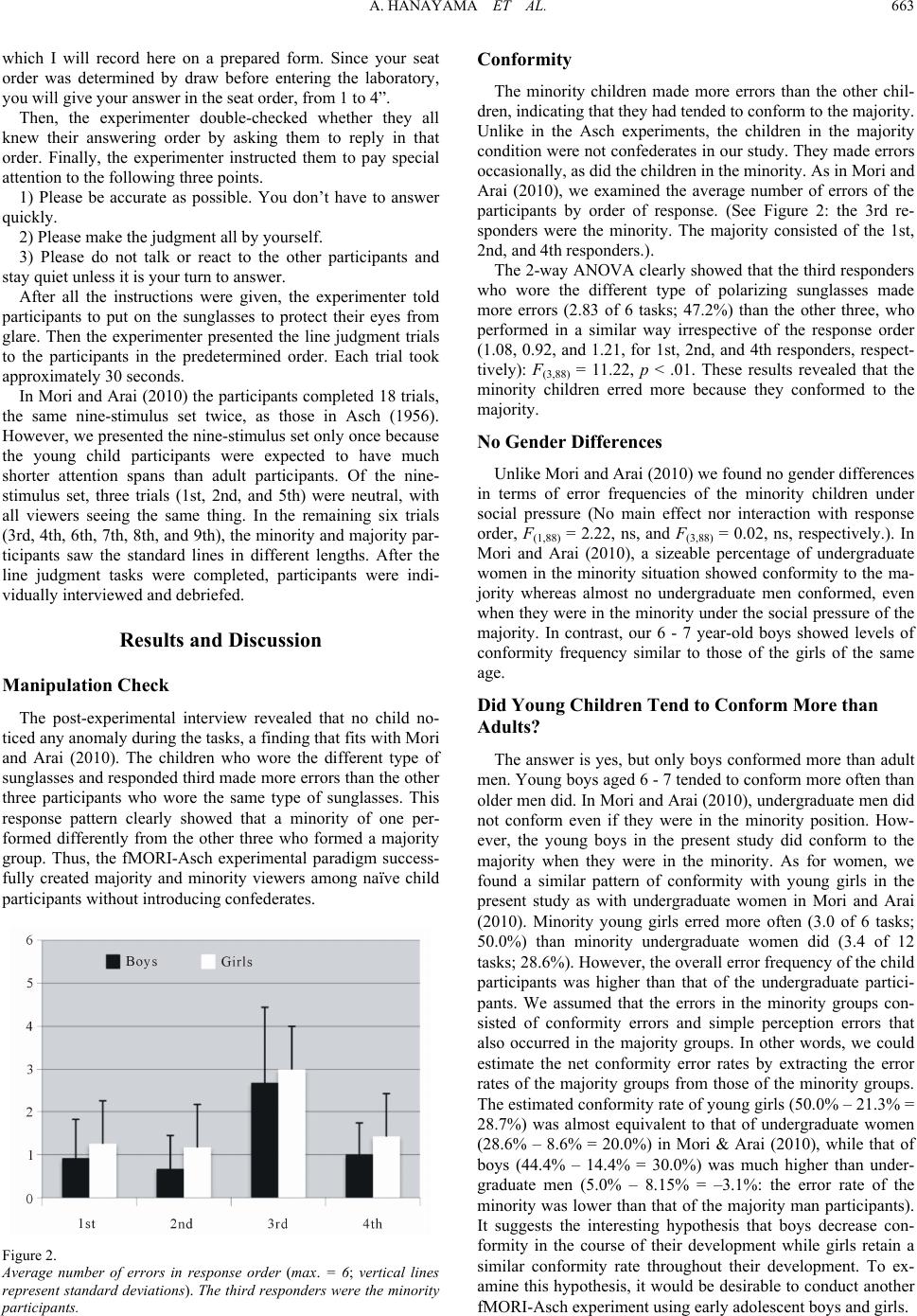
A. HANAYAMA ET AL. 663
which I will record here on a prepared form. Since your seat
order was determined by draw before entering the laboratory,
you will give your answer in the seat order, from 1 to 4”.
Then, the experimenter double-checked whether they all
knew their answering order by asking them to reply in that
order. Finally, the experimenter instructed them to pay special
attention to the following three points.
1) Please be accurate as possible. You don’t have to answer
quickly.
2) Please make the judgment all by yourself.
3) Please do not talk or react to the other participants and
stay quiet unless it is your turn to answer.
After all the instructions were given, the experimenter told
participants to put on the sunglasses to protect their eyes from
glare. Then the experimenter presented the line judgment trials
to the participants in the predetermined order. Each trial took
approximately 30 seconds.
In Mori and Arai (2010) the participants completed 18 trials,
the same nine-stimulus set twice, as those in Asch (1956).
However, we presented the nine-stimulus set only once because
the young child participants were expected to have much
shorter attention spans than adult participants. Of the nine-
stimulus set, three trials (1st, 2nd, and 5th) were neutral, with
all viewers seeing the same thing. In the remaining six trials
(3rd, 4th, 6th, 7th, 8th, and 9th), the minority and majority par-
ticipants saw the standard lines in different lengths. After the
line judgment tasks were completed, participants were indi-
vidually interviewed and debriefed.
Results and Discussion
Manipulation Check
The post-experimental interview revealed that no child no-
ticed any anomaly during the tasks, a finding that fits with Mori
and Arai (2010). The children who wore the different type of
sunglasses and responded third made more errors than the other
three participants who wore the same type of sunglasses. This
response pattern clearly showed that a minority of one per-
formed differently from the other three who formed a majority
group. Thus, the fMORI-Asch experimental paradigm success-
fully created majority and minority viewers among naïve child
participants without intro du c i n g confeder a t e s .
Figure 2.
Average number of errors in response order (max. = 6; vertical lines
represent standard deviations). The third responders were the minority
participants.
Conformity
The minority children made more errors than the other chil-
dren, indicating that they had tended to conform to the majority.
Unlike in the Asch experiments, the children in the majority
condition were not confederates in our study. They made errors
occasionally, as did the children in the minority. As in Mori and
Arai (2010), we examined the average number of errors of the
participants by order of response. (See Figure 2: the 3rd re-
sponders were the minority. The majority consisted of the 1st,
2nd, and 4th responders.).
The 2-way ANOVA clearly showed that the third responders
who wore the different type of polarizing sunglasses made
more errors (2.83 of 6 tasks; 47.2%) than the other three, who
performed in a similar way irrespective of the response order
(1.08, 0.92, and 1.21, for 1st, 2nd, and 4th responders, respect-
tively): F(3,88) = 11.22, p < .01. These results revealed that the
minority children erred more because they conformed to the
majority.
No Gender Differences
Unlike Mori and Arai (2010) we found no gender differences
in terms of error frequencies of the minority children under
social pressure (No main effect nor interaction with response
order, F(1,88) = 2.22, ns, and F(3,88) = 0.02, ns, respectively.). In
Mori and Arai (2010), a sizeable percentage of undergraduate
women in the minority situation showed conformity to the ma-
jority whereas almost no undergraduate men conformed, even
when they were in the minority under the social pressure of the
majority. In contrast, our 6 - 7 year-old boys showed levels of
conformity frequency similar to those of the girls of the same
age.
Did Young Children Tend to Conform More than
Adults?
The answer is yes, but only boys conformed more than adult
men. Young boys aged 6 - 7 tended to conform more often than
older men did. In Mori and Arai (2010), undergraduate men did
not conform even if they were in the minority position. How-
ever, the young boys in the present study did conform to the
majority when they were in the minority. As for women, we
found a similar pattern of conformity with young girls in the
present study as with undergraduate women in Mori and Arai
(2010). Minority young girls erred more often (3.0 of 6 tasks;
50.0%) than minority undergraduate women did (3.4 of 12
tasks; 28.6%). However, the overall error frequency of the child
participants was higher than that of the undergraduate partici-
pants. We assumed that the errors in the minority groups con-
sisted of conformity errors and simple perception errors that
also occurred in the majority groups. In other words, we could
estimate the net conformity error rates by extracting the error
rates of the majority groups from those of the minority groups.
The estimated conformity rate of young girls (50.0% – 21.3% =
28.7%) was almost equivalent to that of undergraduate women
(28.6% – 8.6% = 20.0%) in Mori & Arai (2010), while that of
boys (44.4% – 14.4% = 30.0%) was much higher than under-
graduate men (5.0% – 8.15% = –3.1%: the error rate of the
minority was lower than that of the majority man participants).
It suggests the interesting hypothesis that boys decrease con-
formity in the course of their development while girls retain a
similar conformity rate throughout their development. To ex-
amine this hypothesis, it would be desirable to conduct another
fMORI-Asch experiment using early adoles cent boys and girls.